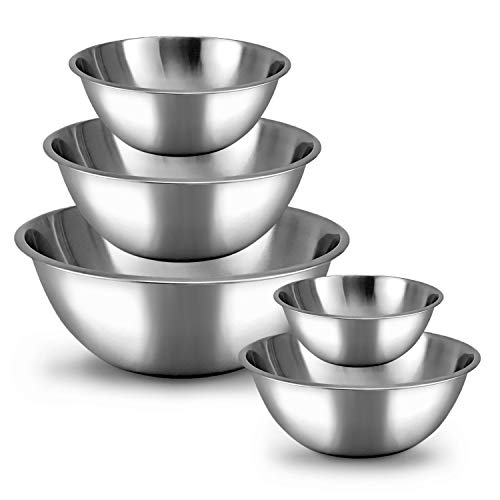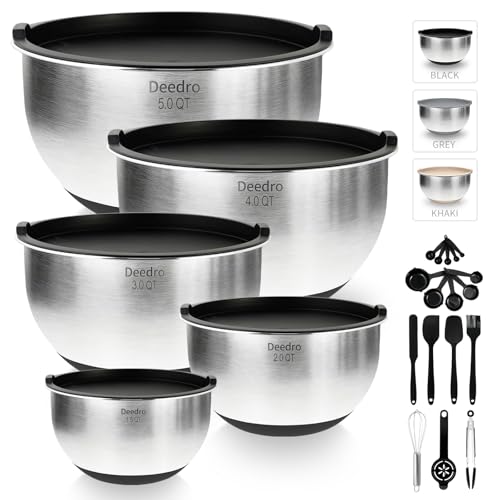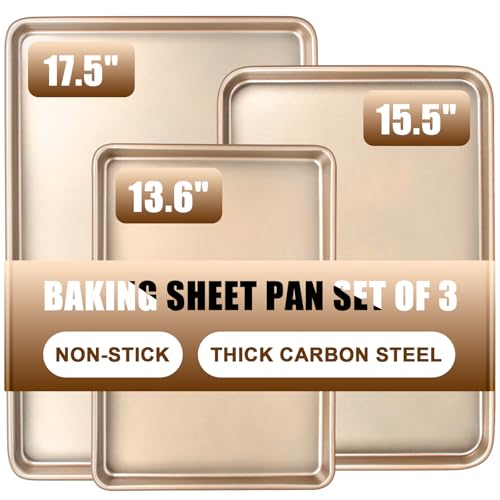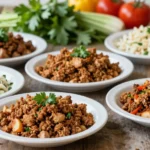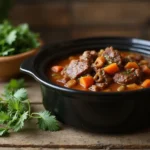Nothing beats the comfort of a perfectly seasoned meatloaf that fills your kitchen with incredible aromas and brings the family together around the dinner table. This easy meatloaf recipe transforms just one pound of ground beef into a hearty meal that’ll satisfy everyone without very costly or taking hours to prepare.
We’ve perfected this foolproof recipe to deliver maximum flavor with minimal effort. You’ll love how simple ingredients like breadcrumbs, eggs, and our secret blend of seasonings create a moist, tender loaf that slices beautifully every time. The best part? It takes less than 15 minutes to mix everything together.
Whether you’re feeding a small family or meal prepping for the week ahead, this one-pound meatloaf hits the sweet spot. It’s substantial enough to feel satisfying yet perfectly portioned to avoid overwhelming leftovers. Get ready to make this your new go-to weeknight dinner that everyone will request again and again.
Ingredients
We’ve carefully selected each ingredient to maximize flavor while keeping the recipe simple and accessible. These pantry staples work together to create a moist and flavorful meatloaf that delivers restaurant-quality results at home.
For the Meatloaf
- 1 lb ground beef (80/20 blend for optimal flavor and moisture)
- 1/2 cup plain breadcrumbs
- 1 large egg
- 1/4 cup milk
- 1 small onion, finely diced
- 2 cloves garlic, minced
- 1 teaspoon salt
- 1/2 teaspoon black pepper
- 1 teaspoon Worcestershire sauce
- 1/2 teaspoon dried oregano
- 1/4 teaspoon smoked paprika
For the Glaze
- 1/3 cup ketchup
- 2 tablespoons brown sugar
- 1 tablespoon apple cider vinegar
- 1/2 teaspoon Dijon mustard
Equipment Needed

We keep our meatloaf equipment list simple because this recipe focuses on ease and efficiency. Our kitchen setup requires just a few essential tools that most home cooks already have on hand.
Essential Mixing Tools:
- Medium mixing bowl for combining all ingredients
- Large mixing spoon or rubber spatula for thorough blending
- Clean hands work perfectly as an alternative mixing method
Baking Equipment:
- Regular-sized bread pan for traditional loaf shape
- Half sheet pan as an alternative baking option
- Aluminum foil for lining the sheet pan if preferred
- Cooking spray for greasing surfaces
Optional but Helpful Tools:
- Meat thermometer for checking internal temperature accuracy
- Small bowl for preparing the glaze mixture
We recommend using either a standard bread pan or a half sheet pan depending on your preference for meatloaf shape. The bread pan creates that classic loaf appearance while the sheet pan allows for more surface area and faster cooking. Both methods deliver excellent results with our recipe.
Our equipment choices prioritize functionality over complexity. The medium mixing bowl provides adequate space for combining 1 lb of ground beef with all seasonings and binding ingredients. We find that clean hands often work better than utensils for achieving the perfect mixture consistency without overworking the meat.
The optional meat thermometer ensures we reach the safe internal temperature of 160°F while preventing overcooking. This simple tool eliminates guesswork and guarantees perfectly cooked meatloaf every time.
Instructions

Now that we have our ingredients ready and equipment set up, let’s jump into the straightforward process of creating this delicious meatloaf. These simple steps will guide us through mixing, shaping, and baking our 1 lb ground beef meatloaf to perfection.
Prep the Ingredients
We start by preheating our oven to 350°F (175°C) to ensure it reaches the proper temperature while we prepare our meatloaf mixture. Next, we finely dice our onion and measure out all remaining ingredients so everything is ready for mixing. This preparation step saves time and prevents any missed ingredients during the mixing process.
Mix the Meatloaf
In our medium mixing bowl, we break the ground beef into small pieces to make mixing easier and ensure even distribution of seasonings. We add the egg, breadcrumbs, diced onion, garlic powder, chili powder, lemon pepper, salt, and ketchup to the bowl with our ground beef. Using clean hands or a large spoon, we mix everything thoroughly until all ingredients are well combined and evenly distributed throughout the meat mixture.
Shape and Place in Pan
We transfer our mixed meatloaf mixture into a regular bread pan, pressing it gently to eliminate air pockets while maintaining a uniform shape. Alternatively, we can shape the mixture into a loaf directly on a baking sheet if we prefer. Using a spatula, we smooth the top surface to create an even finish that will bake uniformly.
Prepare the Glaze
For our classic meatloaf glaze, we spread a thin layer of ketchup over the entire top surface of our shaped meatloaf. This glaze creates a beautiful caramelized finish and adds extra flavor to complement our seasoned meat mixture. The ketchup will develop a rich color and slight sweetness as it bakes.
Bake the Meatloaf
We place our prepared meatloaf in the preheated 350°F oven and bake for 35 to 40 minutes, depending on the thickness of our loaf. The meatloaf is done when it reaches an internal temperature of 160°F (71°C) and shows no pink color in the center. We can check doneness by inserting a meat thermometer into the thickest part of the loaf.
Rest and Serve
Once our meatloaf is fully cooked, we remove it from the oven and allow it to rest for 5 to 10 minutes before slicing. This resting period helps the juices redistribute throughout the meat and makes slicing much easier without the loaf falling apart. We slice our meatloaf into thick portions and serve while still warm for the best texture and flavor.
Tips for Perfect Meatloaf

Mastering the art of meatloaf requires attention to several key techniques that separate good from exceptional results. We’ve gathered these essential tips to help you achieve restaurant-quality meatloaf every single time.
Choose the Right Fat Content
Ground beef with at least 15% fat content ensures your meatloaf stays moist and tender throughout the cooking process. Lean ground beef often results in a dry, crumbly texture that lacks the rich flavor we want in our finished dish.
Sauté Your Aromatics First
Cooking onions and garlic in butter before adding them to the meat mixture transforms their sharp, raw bite into mellow, sweet flavors. This simple step takes just a few minutes but significantly boosts the overall taste profile of your meatloaf.
Avoid Overmixing
Gentle handling preserves the tender texture we’re aiming for in our final product. Mix the ingredients just until they’re combined, then stop. Overworking the meat creates a dense, tough loaf that’s far from the light, juicy result we want.
Add Vegetables for Moisture and Flavor
Incorporating vegetables like diced onions not only enhances flavor but also contributes moisture to keep your meatloaf from drying out during baking. These additions create pockets of flavor throughout each slice.
Test Your Seasoning
Before shaping your entire loaf, cook a small portion of the mixture in a skillet to taste for seasoning balance. This allows you to adjust salt, pepper, or other seasonings before committing to the full recipe.
Monitor Temperature for Perfect Doneness
Baking at 350°F ensures even cooking while checking for an internal temperature of 160°F guarantees food safety. Cooking times vary based on loaf size, so temperature checking provides the most reliable indicator of doneness.
Rest Before Slicing
Allowing your meatloaf to rest for 10 minutes after baking lets the juices redistribute throughout the meat. This resting period makes slicing cleaner and easier while improving the overall texture of each serving.
Storage and Reheating

Once you’ve enjoyed this delicious meatloaf fresh from the oven, proper storage ensures leftovers remain just as flavorful and safe to eat. Following these simple guidelines will help maintain the meatloaf’s moisture and taste for days to come.
Storing Leftovers
Allow the meatloaf to cool completely to room temperature before storing, but never leave it out longer than 2 hours to prevent bacterial growth. Wrap leftover portions tightly in plastic wrap or aluminum foil to maintain moisture and prevent the meat from drying out. Place wrapped meatloaf in an airtight container for extra protection against odors and contamination.
Store your meatloaf in the refrigerator for up to 3-4 days for optimal freshness and food safety. For longer storage, freeze the wrapped meatloaf in a freezer-safe container or double-wrap it in plastic wrap and aluminum foil. Frozen meatloaf maintains its quality for up to 3 months when properly stored.
Reheating Instructions
We recommend using the oven method for the best results when reheating meatloaf. Preheat your oven to 325°F and place the meatloaf slices or whole loaf in an oven-safe dish. Cover with aluminum foil to retain moisture and heat for 15-20 minutes until warmed through.
The microwave offers the quickest reheating option when time is limited. Place a meatloaf slice on a microwave-safe plate and cover loosely with a microwave-safe lid or paper towel. Heat on medium power for 1-2 minutes, checking frequently to ensure even heating throughout the slice.
Always avoid overheating during the reheating process as this can dry out the meatloaf and compromise its texture. Thaw frozen meatloaf overnight in the refrigerator before reheating for the most even results. These proper storage and reheating techniques preserve both the flavor and moistness that make this easy meatloaf recipe so appealing.
Variations and Substitutions

One of the greatest advantages of our easy meatloaf recipe is its incredible adaptability to suit different tastes and dietary needs. We can easily customize this 1 lb beef meatloaf using simple ingredient swaps that maintain the dish’s structure while adding exciting new flavors.
Protein Alternatives
Ground beef serves as our foundation, but we can experiment with different meat combinations for unique textures and flavors. Ground pork mixed with beef creates a richer, more tender meatloaf, while ground turkey offers a leaner option. We recommend combining ground beef with ground veal for an exceptionally smooth texture that rivals restaurant-quality meatloaf.
Binder Options
While our recipe calls for breadcrumbs, we have several excellent alternatives that work just as effectively. Oatmeal functions as an outstanding binder, absorbing moisture while adding subtle texture. Quick oats or regular oats both work well in this application. Crushed crackers provide another reliable option, and cooked rice creates an interesting variation that adds heartiness to each slice.
Vegetable Enhancements
Our basic onion can be enhanced or replaced with different preparations for varied flavor profiles. Caramelized onions add natural sweetness and depth, while green onions provide a milder, fresher taste. We can incorporate grated carrots or zucchini directly into the meat mixture for added moisture and nutrition. Chopped mushrooms work exceptionally well, contributing umami flavor while keeping the meatloaf incredibly moist.
Seasoning Modifications
The spice blend in our recipe adapts beautifully to different flavor preferences. Italian seasoning transforms the meatloaf into a Mediterranean-inspired dish, while chili powder adds warmth and complexity. We can substitute garlic powder with fresh minced garlic for more intense flavor, or add hot sauce for those who prefer spicier food.
Glaze Alternatives
Our ketchup topping can be elevated or completely changed to suit different tastes. Barbecue sauce creates a smoky, tangy finish that pairs beautifully with the beef. We can mix brown sugar with ketchup and Worcestershire sauce for a sweet and savory glaze that caramelizes during baking. Mustard combined with honey offers a sophisticated flavor profile that complements the meat perfectly.
Liquid Adjustments
Adding milk to our mixture creates extra moisture and tenderness, while Worcestershire sauce contributes deep, savory notes. We can substitute beef broth for milk to intensify the meat flavor, or use buttermilk for slight tanginess that enhances the overall taste profile.
These substitutions allow us to create countless variations while maintaining the simplicity and reliability of our core 1 lb beef meatloaf recipe.
Serving Suggestions

We recommend pairing your freshly baked meatloaf with classic comfort sides that complement its rich savory flavors. Creamy mashed potatoes serve as the perfect foundation for this hearty dish. The smooth texture creates an ideal contrast to the meatloaf’s firm consistency while soaking up any delicious pan juices.
Steamed vegetables add essential nutrients and vibrant color to your plate. Green beans work particularly well with their crisp texture and fresh taste. Roasted carrots bring natural sweetness that balances the meatloaf’s savory seasonings. Broccoli florets provide a nutritious option that pairs beautifully with the meat’s robust flavors.
We suggest adding a fresh element to cut through the richness of this satisfying meal. A simple side salad dressed with light vinaigrette brightens the entire dining experience. Mixed greens with cherry tomatoes and cucumber create refreshing contrast. The acidity from the vinaigrette helps cleanse the palate between bites.
Warm dinner rolls complete this traditional American comfort meal. Their soft texture makes them perfect for soaking up any remaining glaze from your plate. Crusty bread offers another excellent option for those who prefer more substantial accompaniments.
For those seeking lighter alternatives we recommend mashed cauliflower as a lower-carb substitute for traditional potatoes. This creamy side maintains the comfort food experience while reducing calories. Roasted Brussels sprouts with bacon bits add sophisticated flavors that elevate the entire meal.
Consider these portions when planning your complete dinner. Each slice of our one-pound meatloaf recipe serves approximately four people when paired with generous sides. This makes meal planning simple for small families or provides perfect leftovers for busy weeknights ahead.
Conclusion
This one-pound meatloaf recipe proves that comfort food doesn’t have to be complicated. We’ve shown you how to create a restaurant-quality meal using simple ingredients and straightforward techniques that anyone can master.
The beauty of this recipe lies in its versatility and reliability. Whether you’re feeding a small family on a busy weeknight or meal prepping for the week ahead this meatloaf delivers consistent results every time.
With our tips for customization and proper storage you’ll never run out of ways to enjoy this classic dish. The combination of tender texture flavorful glaze and endless serving possibilities makes this recipe a true weeknight winner that’ll become a regular in your dinner rotation.
Frequently Asked Questions
How long does it take to prepare this 1-pound meatloaf recipe?
The preparation time is incredibly quick, taking less than 15 minutes to mix all the ingredients together. The total cooking time is 35-40 minutes in a 350°F oven, making this a convenient weeknight dinner option that can be ready in under an hour from start to finish.
What type of ground beef should I use for the best results?
Use ground beef with an 80/20 fat ratio for optimal flavor and moisture. The fat content should be at least 15% to ensure the meatloaf stays juicy and tender. Avoid lean ground beef as it can result in a dry, less flavorful meatloaf.
How many people does this 1-pound meatloaf recipe serve?
This recipe serves approximately four people, making it perfect for small families or couples who want leftovers. Each serving provides a satisfying portion that pairs well with classic sides like mashed potatoes and vegetables.
What’s the secret to making moist and flavorful meatloaf?
The key is using the right fat content in your ground beef, not overmixing the ingredients, and sautéing the onions and garlic before adding them. The special glaze made from ketchup, brown sugar, apple cider vinegar, and Dijon mustard also adds moisture and enhances flavor.
Can I substitute ingredients in this meatloaf recipe?
Yes, this recipe is highly adaptable. You can substitute ground beef with turkey, pork, or veal. Replace breadcrumbs with oatmeal or crushed crackers, and swap milk for beef broth or buttermilk. You can also add vegetables like diced bell peppers or carrots for extra flavor and nutrition.
How do I know when the meatloaf is fully cooked?
The meatloaf is done when it reaches an internal temperature of 160°F (71°C) when measured with a meat thermometer. Visually, the exterior should be nicely browned and the juices should run clear. Let it rest for 5-10 minutes before slicing for the best texture.
How should I store and reheat leftover meatloaf?
Store cooled meatloaf wrapped tightly in plastic wrap or aluminum foil in the refrigerator for 3-4 days. For longer storage, freeze for up to 3 months. Reheat in the oven covered with foil to retain moisture, or use a microwave for quicker heating while avoiding overheating.
What equipment do I need to make this meatloaf?
You’ll need basic kitchen equipment: a medium mixing bowl, large mixing spoon or rubber spatula, and a regular bread pan or half sheet pan for baking. A meat thermometer is optional but recommended to ensure proper doneness. Clean hands work best for mixing the ingredients evenly.
What are the best side dishes to serve with meatloaf?
Classic comfort sides work perfectly: creamy mashed potatoes, steamed green beans or broccoli, and a fresh side salad with vinaigrette. Warm dinner rolls or crusty bread complement the meal nicely. For lighter options, try mashed cauliflower or roasted Brussels sprouts with bacon bits.





